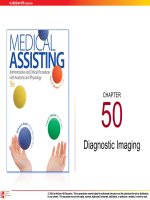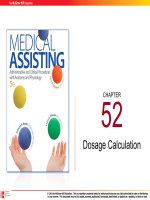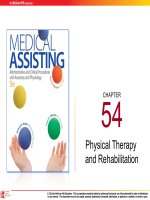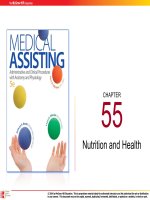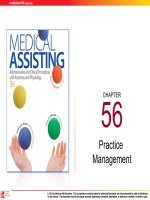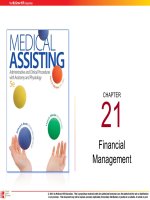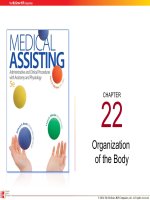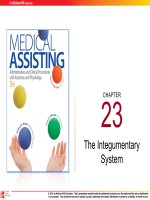Medical assisting Administrative and clinical procedures (5e) Chapter 29 The respiratory system
Bạn đang xem bản rút gọn của tài liệu. Xem và tải ngay bản đầy đủ của tài liệu tại đây (548.85 KB, 44 trang )
CHAPTER
29
The Respiratory
System
29-2
Learning Outcomes (cont.)
29.1 Describe the structure and function of
in the respiratory system.
each organ
29.2 Describe the events involved in the
and expiration of air.
inspiration
29.3 Explain how oxygen and carbon dioxide are
transported in the blood.
29-3
Learning Outcomes (cont.)
29.4 Compare various respiratory volumes and tell how
they are used to diagnose respiratory problems.
29.5 Describe the causes, signs and symptoms, and
treatments of various
diseases and disorders of the
respiratory system.
29-4
Introduction
CO2
• Function
– Move air in and out of lungs
– Delivers oxygen (O2)
CO2
O2
O2
O2
– Removes carbon dioxide (CO2)
• External respiration – in the lungs
• Internal respiration – within the hemoglobin
g
Lun
s CO2
29-5
Organs of the Respiratory System
Nose
Pharynx
Larynx
Trachea
Bronchial tree
Lungs
29-6
Organs of the Respiratory System (cont.)
• Nasal Cavity
– Nasal septum
– Nasal conchae
– Mucous membrane warms and moistens the
air
– Cilia eliminate particles
To Diagram
29-7
Organs of the Respiratory System (cont.)
• Paranasal Sinuses
– Air-filled spaces
within the skull
bones
– Equalize pressure
– Reduce the weight
of the skull
– Give the voice its
tone
29-8
Organs of the Respiratory System (cont.)
• Pharynx
• Larynx
– Moves air in and out of the trachea
– Produces sounds of the voice
– Cartilage and muscle
– Epiglottis
Layrnx
Reparatory
system
29-11
Organs of the Respiratory System (cont.)
• Trachea
– Tubular organ made of rings of cartilage and
smooth muscle
– Extends from the larynx to the bronchi
– Lined with cells possessing cilia
To Diagram
29-12
Organs of the Respiratory System (cont.)
• Vocal cords
– Between the thyroid cartilage and the cricoid
cartilage
– Glottis~ the opening between the vocal
cords
– Upper ~ false cords
– Lower ~ true vocal cords
29-13
• Bronchial tree – branches off the trachea
– Bronchi
Organs
of the Respiratory System (cont.)
• Primary or main stem
• Secondary
• Tertiary
– Bronchioles ~ branch off tertiary bronchi
To Diagram
29-14
Organs of the Respiratory System (cont.)
• Alveoli
– Thin sacs of cells surrounded by capillaries
– “Working tissue”
– Cellular respiration
• Carbon dioxide released into alveoli
• Oxygen released into the blood
To Diagram
29-16
Lungs
• Cone-shaped organs
• Right lung – three lobes
• Left lung – two lobes
The lungs contain connective tissue, the bronchial
tree, nerves, lymphatic vessels, and blood vessels.
To Diagram
29-17
Lungs
• Pleura
– Membranes surrounding the lungs
– Parietal pleura
– Visceral pleura
– Pleural fluid
• Surfactant – keeps alveoli from collapsing
29-18
Apply Your Knowledge
True or False ANSWER:
T The nasal conchae supports the mucus membrane and
increases the surface area in the nasal cavity.
F The larynx functions for both the respiratory and
digestive systems
pharynx
T Lower vocal cords produce sound and are the true vocal
cords.
T Surfactant keeps the alveoli from collapsing between
inspirations.
alveoli
F The bronchioles are the “working tissue” of the lungs
29-19
The Mechanisms of Breathing
Inspiration
The diaphragm contracts and flattens
The intercostal muscles raise the ribs
Air rich in O2 enters the lungs
Breathing
Diagram
29-20
The Mechanisms of Breathing
Expiration
The diaphragm relaxes
The intercostal muscles lower the
ribs
Air rich in CO2 exits the lungs
Breathing, or pulmonary ventilation, consists
of inspiration and expiration.
Breathing
Diagram
29-22
The Mechanisms of Breathing (cont.)
• Respiratory center
of the brain
– Medulla oblongata
~ rhythm and depth
of breathing
– Pons ~ rate of
breathing
• Other factors
– CO2 levels in the
blood
– pH of the blood
– Fear and pain
– Inflation reflex
29-23
The Mechanisms of Breathing (cont.)
• Causes of altered breathing patterns
– Coughing
– Sneezing
– Laughing
– Crying
– Hiccups
– Yawning
– Speaking
29-24
Apply Your Knowledge
Indicated whether each statement refers to (I) inhalation
or (E) exhalation:
ANSWER:
E The intercostal muscles lower the ribs
__
I The diaphragm contracts or flattens
__
I The intercostal muscles raise the ribs
__
E The diaphragm relaxes
__
I Air rich in O2 enters the lungs from the atmosphere
__
E Air rich in CO exits the lungs
__
2
29-25
The Transport of Oxygen and Carbon
Dioxide in the Blood
• Oxygen
– Oxygen binds to hemoglobin – oxyhemoglobin
– Bright red in color
• Small amount oxygen remains dissolved in
plasma
29-26
The Transport of Oxygen and Carbon
Dioxide in the Blood (cont.)
• Carbon Dioxide
– Binds to hemoglobin ~ carboxyhemoglobin
– Most carbon dioxide goes into the plasma
– RBCs convert it to carbonic acid used to
regulate the pH of the blood
29-27
Apply Your Knowledge
Describe what happens to carbon dioxide in
the blood.
ANSWER: Carbon dioxide can combine with
hemoglobin and form carboxyhemoglobin.
Most is converted to carbonic acid by RBCs.
Super!
29-28
Respiratory Volumes
• Different volumes of air
move in and out of lungs
with different intensities of
breathing
• Measured to assess
health of respiratory
system
29-29
Respiratory Volumes (cont.)
Tidal
Volume
Amount of air that moves in or
out of the lungs during a normal
breath
Inspiratory
Reserve
Volume
Amount of air that can be
forcefully inhaled following a
normal inhalation
Expiratory
Reserve
Volume
Amount of air that can be
forcefully exhaled following a
normal exhalation
